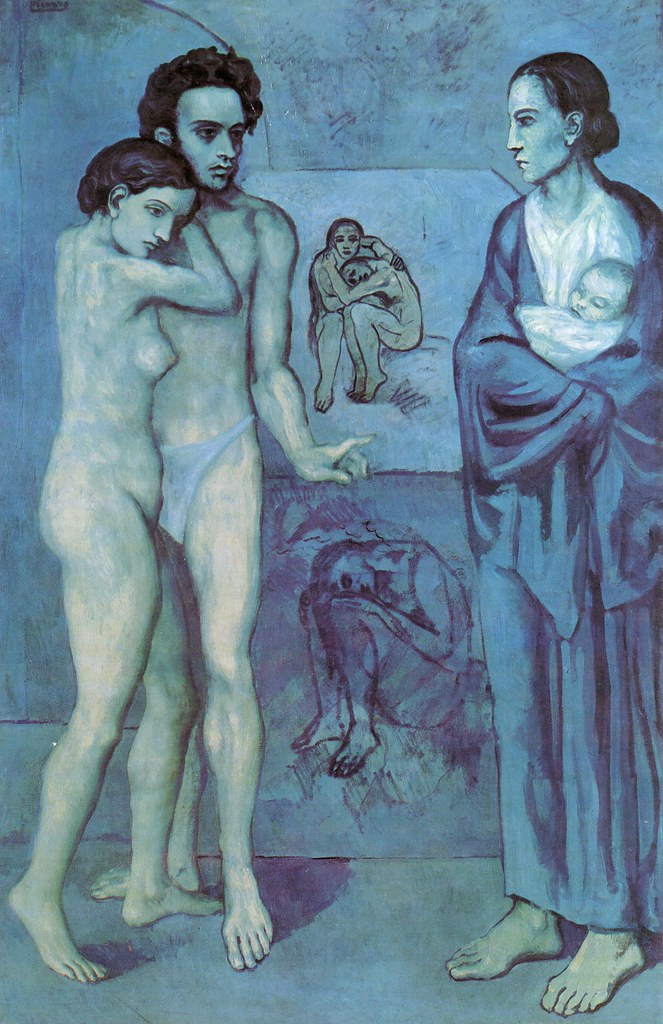
Looking back at my journey through that grief, I can see that I had to descend into the pain of that loss before I could emerge on the other side of it. While I’ll never completely heal from my dad’s death, it has become a scar I carry instead of an open wound. That coping process took time, though, and the way was unclear.
In my study of art history, I recognized a similar coping process in Pablo Picasso’s life. He also experienced intense loss and found a way through grief by expressing his sorrow and depression. The paintings he crafted during that time are known as his Blue Period. Though he depicted his emotions in dreary colors and subjects, the artwork that he created is some of his deepest and most moving painting. Some would say this period generated some of his most beautiful work.
I think these paintings are so beloved and relatable because we all encounter “blue periods,” and we can recognize in Picasso’s work a search for light in the darkness. We can see him wrestling with sorrow, and turning it into something beautiful.
Picasso’s Blue Period
The masterpieces that might come to mind when I say the name Pablo Picasso might include his proud Guernica (1937), his playful Les Demoiselles d'Avignon (1907), or his striking Weeping Woman (1937), all of which now adorn the most famous museums in the world. He is known by many as the co-founder of cubism and the father of modern art, a man who is often misunderstood and underappreciated because of the abstractions in his paintings.
But Picasso didn’t always live in the warm spotlight of artistic glory. On the contrary, he spent years of his youth in the cold, miserable depths of depression rooted in the loss of a close friend. Spanish painter and poet Carlos Casagemas had been Pablo Picasso’s roommate in Barcelona. On February 17, 1901, he committed suicide in a Parisian café during a party in the presence of his own guests.
Picasso and Casagemas were both 20 years old, were both native Spaniards, and were young men who had grown close to each other through their involvement in French and Spanish art circles. Devastated by the suicide of Casagemas, Picasso began mourning his good friend’s death by expressing his grief through his painting.
Picasso began using an exclusively blue palette, often darkened by blacks and browns, to create hopeless scenes and focus on hopeless subjects. The paintings from this Blue Period showcased elongated figures (inspired by 16th century Spanish painter El Greco) of people who were hungry, cold, homeless, sad, or otherwise physically and emotionally impoverished.

Perhaps the most well-known painting from the Blue Period was The Old Guitarist (1903). The entire canvas displays a thin, old man playing a guitar on the cold ground. His shirt is ripped at the shoulder, his body is contorted downwards, and he sits alone in a dark corner.
The Tragedy (1903) also demonstrates Picasso’s depression. In this painting, three people — presumably a mother, a father, and a child — stand at the shore of an open sea. The mother and father are wrapped in shawls, closed in, barefoot, and seemingly cold. They are turned away from their child while he seeks attention from the father, placing his hand on the father’s leg. The Tragedy might describe an event that happened before this scene, causing the illustrated depression; or it might describe the scene itself, where we witness a family completely disconnected. Either way, Picasso is conveying a deep sadness to his audience, which is just as palatable now as it was in 1903.

La Vie (1903) is potentially the most complex work of Picasso’s Blue Period. The various elements of the painting remain mysterious and open to interpretation in the art community. In the foreground of this image, we see a naked couple embracing on the left and a mother holding a baby with its eyes closed on the right. The background holds images of nude figures sitting alone or embracing, contorted downward in the same manner as The Old Guitarist.
The man represented on the left side of the painting is Carlos Casagemas; Picasso paints him alive and in the company of a nude woman, a reality that Casagemas struggled to achieve when he was alive. Prior to his suicide, Casagemas had been exhibiting signs of depression and mood swings, accompanied by morphine use. It’s widely accepted that the reason for his depression was his unrequited love for Germaine Pichot, a model he and Picasso had painted in the past. Pichot rejected Casagemas due to his impotence and inability to consummate their relationship.

The details of Casagemas and Pichot were known to Picasso and influenced his art, particularly in La Vie. Picasso depicts Casagemas’ lost desire for children by capturing him pointing his finger toward the mother and child. The child, some art critics propose, has its eyes closed not because it is sleeping, but because it is dead. Casagemas could never have children because of his impotence, and Picasso embraced and immortalized this deep pain on his canvas.
The Blue Period has gone down in history as one of the most iconic, recognizable, and expressive timeframes in any single artist’s life. Despite the depression that permeates Picasso’s canvases, the paintings have become beloved by those who have seen them and are now sold as treasures, priced according to their beauty. One of his Blue Period paintings — Nightclub Singer (1901) — broke a record for sales price after being auctioned off at $67.5 million in 2015. The humble subjects of these masterpieces are solemn and Picasso painted them in utter sadness, yet they possess a mysterious beauty within them that has survived many generations of art.
Our own Blue Period
Picasso isn’t alone in the brokenness and despair he felt following the suicide of Casagemas. We have all felt our own “blue periods” — it’s part of the human condition. Perhaps we don’t paint through our Blue Periods, but the same darkness that lurks in the shadows of Picasso’s palette can creep into our lives through disease, poverty, loneliness, or death.
I was just 23 years old when my young, brilliant father died and my own Blue Period arrived. I had recently graduated from college, and engaged to the man of my dreams. My entire life was picturesque until a sudden massive heart attack took my father’s life in the blink of an eye. Like Picasso losing Casagemas, there was no warning and no farewell. The death stunned our entire small family as we cascaded into hysterical disbelief, followed by a deep and desperate grief. We were broken and we humbly reached for each other to climb out of our darkness.
It was in this Blue Period of mourning for my father when I remembered the words of a favorite philosopher who said that we find light in darkness when we enter into that darkness with others. The idea seemed to capture the journey through darkness and suffering that I had to undertake. I couldn’t avoid it — I had to descend into the darkness to find the light.
The poverty and sorrow found in Picasso’s Blue Period paintings became some of the most brilliant and beautiful expressions in history. I found a similar hidden virtue buried in my suffering. For the first significant time in my life, I was humbled by pain. I found myself weak, incapable, and dependent.
Sharing this common brokenness — whether in famous artwork or in our own experience — unites us to each other. We all encounter the humiliations of hunger, homelessness, disease, depression, and death in one form or another. The way through is to enter that darkness, to embrace vulnerability.
Perhaps Picasso discovered this light while painting his darkness, and it became a path for him through it. After all, his Blue Period was followed by his brighter, joyful Pink Period.




















